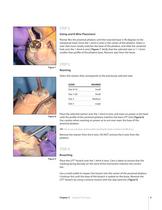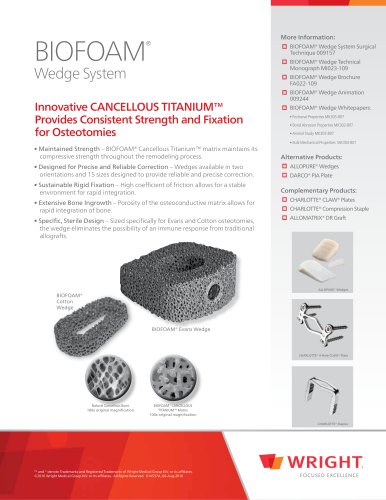
Catalog excerpts

Precise, cannulated instrumentation. SURGICAL TECHNIQUE
Open the catalog to page 1
Chapter 1 4 Product Information Chapter 2 6 Preoperative Planning Chapter 3 7 Surgical Technique 9 Sizing and K-Wire Placement 11 Optional Suture Placement 12 Angled LPT® Great Toe Implant Chapter 4 13 Ordering Information 14 LPT® Great Toe Instrument Kit Proper surgical procedures and techniques are the responsibility of the medical professional. The following guidelines are furnished for information purposes only. Each surgeon must evaluate the appropriateness of the procedures based on his or her personal medical training and experience. Prior to use of the system, the surgeon should...
Open the catalog to page 3
Design Features Bone conserving, thin profile (page 8) ^) Cruciate stabilizing stem Soft tissue securing suture holes ^) Biocompatible Titanium implants (ASTM F67Grade4) Deep Dish Articulation Chapter 1 Product Information
Open the catalog to page 4
Implant Specifications Lateral Length Medial Length Product Information
Open the catalog to page 5
Preoperative Planning Any great toe joint implant arthroplasty requires consideration of the following general requirements: · Good neurovascular status · Adequate skin mobility and coverage · Functional great toe flexor power · Adequate bone stock to receive implant Informed consent that revision or arthrodesis may be necessary. Indications Use of the titanium LPT® Great Toe Implant may be considered for cases of first metatarsophalangeal joint degenerative arthritis in the presence of good bone stock, integrity of the metatarsal head and the following conditions: · Hallux valgus: mild to...
Open the catalog to page 6
As Described By Lowell Scott Weil, Sr, DPM, FACFAS Surgical Technique Incision and Exposure A 5cm dorsal medial incision is made just medial to the extensor hallucis tendon | Figure 1. Appropriate dissection is used to expose the joint capsule. Careful preservation of the superficial vessels and nerves is undertaken. The skin is retracted and an incision is made to the bone, in-line with the skin incision. The capsular tissues are carefully dissected from the base of the proximal phalanx and first metatarsal head, on the medial, dorsal, and anterolateral aspect | Figure 2. Often, there is a...
Open the catalog to page 7
STEP 1 Base Resection Using a bone clamp or large towel clamp, the base is elevated | Figure 3. 2-6mm of bone is resected from the base of the proximal phalanx | Figure 4. The amount of bone resected will vary by patient, but joint decompression must be considered when making this determination. The base resection is carried out perpendicular to the long axis of the toe, not the proximal phalanx | Figure 5. In this manner, DASA (Distal Articular Set Angle) may be corrected concurrently. Figure 3 Tip : During base resection, remove more bone plantarly than dorsally to allow for ideal...
Open the catalog to page 8
STEP 2 Sizing and K-Wire Placement Plantar flex the proximal phalanx until the resected base is 90 degrees to the metatarsal head. Drive the 1.4mm k-wire in the center of the phalanx. Select a sizer that most closely matches the base of the phalanx, and slide the centered hole over the 1.4mm k-wire | Figure 7. Verify that the selected sizer is 1-1.5mm smaller than profile of the phalanx base. Remove sizer from the bone. STEP 3 Reaming Select the reamer that corresponds to the previously selected sizer. Sizer Reamer Size 0/1A Medium Large Place the selected reamer over the 1.4mm k-wire, and...
Open the catalog to page 9
STEP 5 Trial Select an implant trial that corresponds to the sizer previously selected, and place the trial stem in the broached hole. Ensure the marking on the dorsal side of the trial corresponds to the correct toe | Figure 10. Sizer Trial Implant Use a small mallet and the implant impactor to seat the trial into the base of the proximal phalanx | Figure 11. With the trial in place, remove excess bone and osteophytes with a bone rongeur | Figure 12. Reduce the joint and flex the phalanx dorsally and plantarly, checking for range of motion. Figure 11 If range of motion and overall fit of...
Open the catalog to page 10
Optional Suture Procedure Make certain that the selected implant is held in the proper alignment so that the stem fits the broached hole. DO NOT INSERT THE IMPLANT UNTIL THE PLANTAR SUTURE IS PLACED. Holding the great toe in distal traction, pass a suture through the intersesamoidal ligament catching the flexor hallucis longus tendon | Figure 13 and then through the hole on the plantar surface of the implant | Figure 14. Repeat this maneuver again to create a pulley type suture. Place the implant into the proximal phalanx and tamp firmly with the implant impactor and a small mallet....
Open the catalog to page 11
Angled LPT® Great Toe Implant The Angled LPT® Great Toe implant is used to accommodate an increased PASA (Proximal Articular Set Angle) or DMAA (Distal Metatarsal Articular Angle) deformity of the articular cartilage of the first metatarsal | Figure 17. The wider portion of the implant is always placed laterally. The technique of the Angled LPT® Great Toe is essentially the same as that of the Regular LPT® Great Toe with the following addition: a medial perforation hole has been placed in the Angled LPT® Toe. During capsular closure, the surgeon may select to place an absorbable suture in...
Open the catalog to page 12
Ordering Information LPT® Great Toe Implant Catalog No. LPT® REGULAR GREAT TOE SIZE 0 LPT® REGULAR GREAT TOE SIZE 1 LPT® REGULAR GREAT TOE SIZE 2 LPT® REGULAR GREAT TOE SIZE 3 LPT® ANGLED GREAT TOE SIZE 1 LPT® ANGLED GREAT TOE SIZE 2 Ordering Information
Open the catalog to page 13
LPT® Great Toe Cannulated Instrument Kit 24872001 1 LPT® GREAT TOE SIZER SZ 0-1 24872002 1 LPT® GREAT TOE SIZER SZ 2-3 24872020 1 LPT® GREAT TOE REAMER SMALL 24872003 1 LPT® GREAT TOE REAMER MEDIUM 24872004 1 LPT® GREAT TOE REAMER LARGE 24872005 1 LPT® GREAT TOE BROACH 24872006 1 LPT® GREAT TOE IMPACTOR STRAIGHT 24872007 1 LPT® GREAT TOE IMPACTOR ANGLED 24872008 1 LPT® GREAT TOE ELEVATOR 24872009 1 LPT® GREAT TOE SLAPHAMMER 24872010 1 LPT® GREAT TOE TRIAL SZ0 24872011 1 LPT® GREAT TOE TRIAL SZ 1 24872012 1 LPT® GREAT TOE TRIAL SZ 2 24872013 1 LPT® GREAT TOE TRIAL SZ 3 24872014 1 LPT® GREAT...
Open the catalog to page 14All Wright Medical Technology catalogs and technical brochures
-
Focused on Biologics
2 Pages
-
Wright Code of Business Conduct
36 Pages
-
FORCE FIBER
4 Pages
-
BIOFOAM®
1 Pages
-
TENSIX
2 Pages
-
ALLOPURE
6 Pages
-
MEDIALMAX
2 Pages
-
DARCO™
1 Pages
-
INVISION™
2 Pages
-
PROPHECY
6 Pages
-
SWANSON Flexible Hinge Toe
1 Pages
-
css
4 Pages
-
CL AW ® II
20 Pages
-
Hemi Phalangeal Implant
2 Pages
-
EVOLVE PROLINE
2 Pages
-
ALLOMATRIX C Brochure
2 Pages
-
Darco MFS ? SO117?407
8 Pages
-
Darco MRS ? SO118?407
8 Pages














































